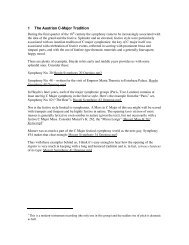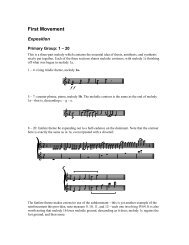Mozart Symphony No. 39 (PDF) - Scott Foglesong
Mozart Symphony No. 39 (PDF) - Scott Foglesong
Mozart Symphony No. 39 (PDF) - Scott Foglesong
You also want an ePaper? Increase the reach of your titles
YUMPU automatically turns print PDFs into web optimized ePapers that Google loves.
&bbbb bÏ n# Ï # Ï # # Ï #Ï<br />
?<br />
bb bb Ï<br />
Ï # Ï<br />
Ï #<br />
# Ï<br />
Ï # n Ï<br />
# Ï nÏ<br />
{<br />
This is even quite easy to handle in analysis: the enharmonic shift creates a modally mixed<br />
submediant (#VI) in the key of B-minor, followed by a mixed cadential 6/4, which then cadences<br />
comfortably into B Major. (One could also analyze the passage as being in B Major—thus neither<br />
the submediant nor the cadential 6/4 are heard as mixed, with the arrival at the minor tonic a<br />
modal shift.)<br />
However, in the return to A-flat major <strong>Mozart</strong> takes a long, circuitous, and utterly fascinating<br />
journey through the possibilities of chromatic harmony. I have generally found attempts to<br />
analyze these kinds of progressions using functional analysis symbols frustrating, fruitless, and<br />
ultimately singularly unenlightening. The technique can be summed up as:<br />
• Move chromatically in outer voices<br />
• Maintain at least one common tone between any pair of chords<br />
Thus <strong>Mozart</strong> creates a slowly shifting kaleidoscope of harmonies, which do indeed find their way<br />
back to A-flat major, via an augmented sixth chord. Here is the distillation, beginning with<br />
measure 99 and continuing through to measure 109, at which point a clear dominant in A-flat<br />
major has been reached:<br />
&bbbb # n<br />
n Ï n# ÏÏ nÏ bÏ nnb b<br />
Ï b Ï<br />
?<br />
bb bb Ï Ï<br />
n Ï Ï Ï Ï bÏ n Ï Ï Ï Ï bÏ<br />
{<br />
b Ï<br />
b Ï Ï Ï n n Ï Ï<br />
Ï<br />
bÏ<br />
bÏ Ï Ï n<br />
n Ï Ï b<br />
b Ï Ï<br />
<strong>No</strong>w, I suppose with enough strain and bother one could manage to give all these chords<br />
meaningful labels—but I don’t think they would tell you much of anything about the real motion.<br />
The primary key is to see the reverse of the previous action: the opening B-minor triad becomes<br />
an A-flat minor triad in first inversion (sixth chord) which then acts as a modally-mixed<br />
subdominant to E-flat major, which is V of A-flat. But the real magic lies in the chords in<br />
between—a shifting pattern of sonorities, created contrapuntally rather than harmonically. This<br />
practice is both ahead of its time (the 19 th century would capitalize on this kind of motion) and is<br />
also wonderfully archaic as well—being fundamentally the same procedure as that which guided<br />
the ears of the great Renaissance writers such as Josquin or Palestrina.





